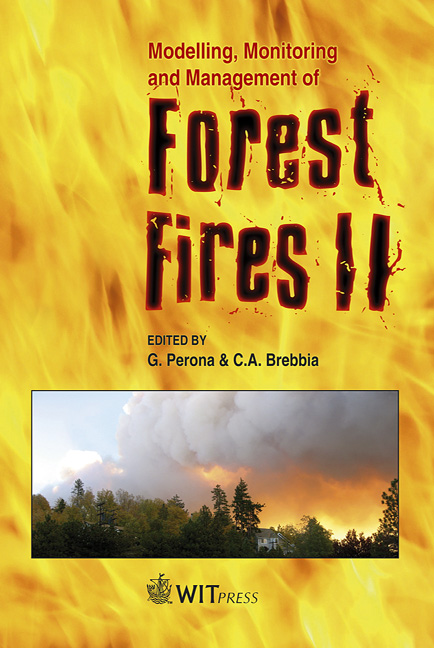Correlation Analysis And Fuel Moisture Estimation Based On FMA And FMA+ Fire Danger Indices In A Pinus Elliottii Plantation In Southern Brazil
Price
Free (open access)
Transaction
Volume
137
Pages
11
Page Range
3 - 13
Published
2010
Size
602 kb
Paper DOI
10.2495/FIVA100011
Copyright
WIT Press
Author(s)
J. F. Pereira, A. C. Batista & R. V. Soares
Abstract
This research was carried out in a Pinus elliottii plantation, established in 1984, with 47.16 m2.ha–1 of basal area, located in the Rio Negro Forest Research Station, owned by the Paraná Federal University, Paraná State, southern Brazil. The research objectives were to analyze the correlations between the FMA and FMA+ fire danger indices and the fine fuel moisture, and develop mathematical models to estimate the fuel moisture based on those indices. The meteorological variables were obtained from the SIMEPAR weather station, located 50km away, and from a pluviograph and a thermo-hygrograph installed in the study area. The dead forest fuels were collected from 30x30cm plots, between 12 noon and 2:00PM, and classified as: AA – surface layer; AB – intermediate layer; AC – lower layer; and B – woody material with 0.7 to 2.5cm diameter. The average fuel layer thickness ranged from 14.8 to 15.3cm. The total fuel load varied from 3185.50 to 4266.01g.m–2. The fire danger indices were calculated daily and the values obtained on the fuel collecting days were used to calculate the correlations. The correlation coefficients between relative humidity and fuel classes were 0.42, 0.36, 0.32, and 0.41 for the AA, AB, AC, and B classes, respectively. The correlation coefficients between precipitation and fuel classes were 0.57, 0.38, 0.34, and 0.15 for the AA, AB, AC, and B classes, respectively. Higher correlation coefficients were obtained between fuel moisture and fire danger indices. The correlation coefficients between the fuel classes and the FMA+ were -0.53, -0.56, -0.63, and 0.81 for the classes B, AB, AA, and AC,
Keywords
Pinus elliottii, fire danger indices, forest fuel, forest protection





